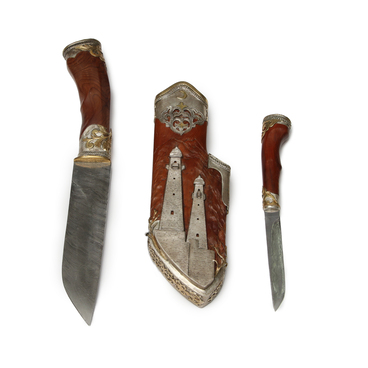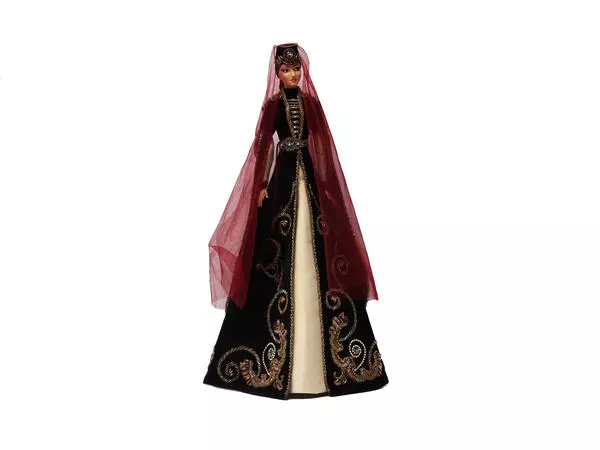The traditional Ingush male dress is similar in shape and cut to the clothes of other Caucasians. The main elements of the costume included a shirt, trousers, a beshmet, a cherkeska, a headpiece, shoes, and weapons.
A beshmet is a tight-fitting caftan with a high standing collar. It was worn every day, as well as for special occasions; however, simpler materials were used for the everyday version. Men and even boys from the age of 10 until old age wore a beshmet.
If a highlander went somewhere, to a mosque or to village gatherings, he put on a cherkeska over the beshmet. A cherkeska (chokha) is a type of outerwear, it is a swing single-breasted caftan without a collar, with an open neckline and long sleeves. The length of the cherkeska coat was not strictly defined, but for the Ingush, it usually went several centimeters below the knees. The front flaps and sleeves were sheathed with a decorative cord, cartridges for gunpowder were sewn on both sides of the chest (covers for gazyrs).
The Russians called the chokha — ‘cherkeska’, because they saw it for the first time being worn by Circassians (‘cherkessy’ in Russian). Although, almost all Caucasians wore a chokha, including the Ingush. Usually, cherkeskas were made of gray, black, light gray, or white fabric. Most often, they were black, because only the wealthy could afford elegant light-colored clothes.
The cherkeska was always worn buttoned up, belted with a girdle made of a narrow belt with a metal buckle and plates of various shapes. A dagger was necessarily attached to the belt. It was decorated with engraving and niello, like the saber. The scabbard for the weapon was covered in leather and velvet. Since the end of the 19th century, the dagger, like the gazyrs, has transformed from a necessary weapon into a mandatory decoration of a highlander’s outfit.
All these features of traditional men’s clothing are visible in the doll displayed in the museum. It was created by Aina Inarkieva — a well-known fashion designer, historian of folk costumes.
The craftswoman has devoted more than 12 years of her life to recreating the technique of sewing the ancient Caucasian costumes and their accessories. Many experts deem her work as a huge contribution to the revival of the ancient folk crafts of Ingushetia. In the 1950s and 1960s, the Ingush traditional costume practically disappeared: because of the tragedy of the deportations ordered by Stalin in 1944, there were no specialists left in Ingushetia who could have mastered the sewing technique, nor the old costumes themselves because the military destroyed all cultural objects.
The Ingush tried to preserve the few relics that they took with them during the deportation. People gave the wedding dresses to each other for special occasions, and even after rehabilitation in 1957 (up until the 90s), the custom of renting jewelry to the newlyweds remained.
Today, the craftswoman has to recreate the national culture, studying not only the sewing technique but also the archival data, ancient photographs, and rare preserved artifacts.
A beshmet is a tight-fitting caftan with a high standing collar. It was worn every day, as well as for special occasions; however, simpler materials were used for the everyday version. Men and even boys from the age of 10 until old age wore a beshmet.
If a highlander went somewhere, to a mosque or to village gatherings, he put on a cherkeska over the beshmet. A cherkeska (chokha) is a type of outerwear, it is a swing single-breasted caftan without a collar, with an open neckline and long sleeves. The length of the cherkeska coat was not strictly defined, but for the Ingush, it usually went several centimeters below the knees. The front flaps and sleeves were sheathed with a decorative cord, cartridges for gunpowder were sewn on both sides of the chest (covers for gazyrs).
The Russians called the chokha — ‘cherkeska’, because they saw it for the first time being worn by Circassians (‘cherkessy’ in Russian). Although, almost all Caucasians wore a chokha, including the Ingush. Usually, cherkeskas were made of gray, black, light gray, or white fabric. Most often, they were black, because only the wealthy could afford elegant light-colored clothes.
The cherkeska was always worn buttoned up, belted with a girdle made of a narrow belt with a metal buckle and plates of various shapes. A dagger was necessarily attached to the belt. It was decorated with engraving and niello, like the saber. The scabbard for the weapon was covered in leather and velvet. Since the end of the 19th century, the dagger, like the gazyrs, has transformed from a necessary weapon into a mandatory decoration of a highlander’s outfit.
All these features of traditional men’s clothing are visible in the doll displayed in the museum. It was created by Aina Inarkieva — a well-known fashion designer, historian of folk costumes.
The craftswoman has devoted more than 12 years of her life to recreating the technique of sewing the ancient Caucasian costumes and their accessories. Many experts deem her work as a huge contribution to the revival of the ancient folk crafts of Ingushetia. In the 1950s and 1960s, the Ingush traditional costume practically disappeared: because of the tragedy of the deportations ordered by Stalin in 1944, there were no specialists left in Ingushetia who could have mastered the sewing technique, nor the old costumes themselves because the military destroyed all cultural objects.
The Ingush tried to preserve the few relics that they took with them during the deportation. People gave the wedding dresses to each other for special occasions, and even after rehabilitation in 1957 (up until the 90s), the custom of renting jewelry to the newlyweds remained.
Today, the craftswoman has to recreate the national culture, studying not only the sewing technique but also the archival data, ancient photographs, and rare preserved artifacts.




